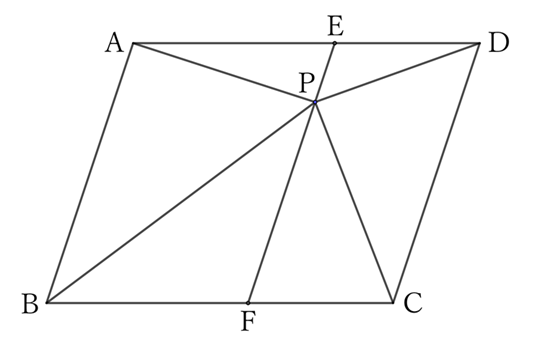A necessary and sufficient condition for a quadrilateral $ABCD$ to be a parallelogram is that for any point $P$ in the quadrilateral, the following holds:
$$△PAB+△PCD=\frac{1}{2}◻ABCD. \qquad [*]$$
Show that this condition is necessary and sufficient.
$\downarrow$ $\downarrow$ $\downarrow$ $\downarrow$ $\downarrow$
$$ $$Solution

$(1)$ Necessary condition
Let the quadrilateral $ABCD$ be a parallelogram, and the points $E$ and $F$ are where the line that passes through $P$ and is parallel to $AB$ intersects with $DA$ and $BC$.
Then, since $EF$ is also parallel to $CD$, and both $◻ABFE$ and $◻CDEF$ are parallelograms,
$$◻ABCD=◻ABFE+◻CDEF,$$
$$△PAB=\frac{1}{2}◻ABFE \qquad and \qquad △PCD=\frac{1}{2}◻CDEF,$$
$$∴ \ △PAB+△PCD=\frac{1}{2} (◻ABFE+◻CDEF),$$
$$∴ \ △PAB+△PCD=\frac{1}{2}◻ABCD.$$
$(2)$ Sufficient condition
Assume $[*]$.
Then, for any quadrilateral $ABCD$, no matter where $P$ is located on $EF$ drawn parallel to $AB$, the area of $△PAB$ is always constant.
However, from $[*]$, $△PAB+△PCD$ is always constant.
Thus, the area of $△PCD$ is also always constant.
Therefore,
$$EF∥CD,$$
$$∴ \ AB∥CD. \qquad [1]$$
Similarly,
$$DA∥BC. \qquad [2]$$
From $[1]$ and $[2]$, if $[*]$, then the quadrilateral $ABCD$ is a parallelogram.
Reference Teiichiro Sasabe (1976) The Encyclopedia of Geometry (2nd edition), Seikyo-Shinsha, p.45.